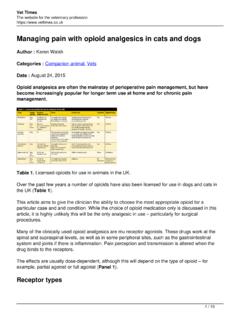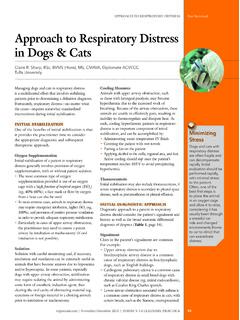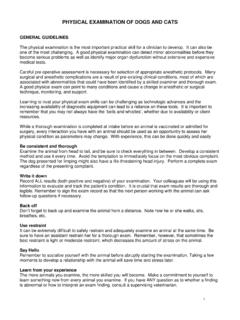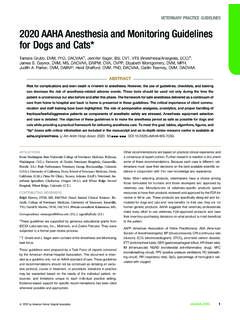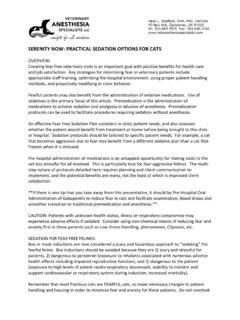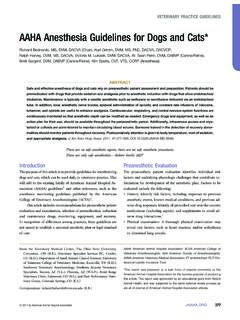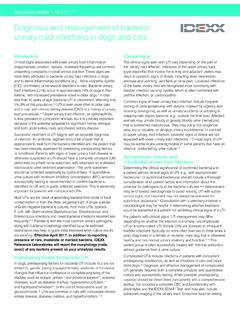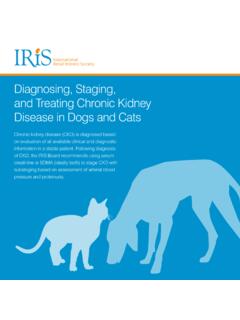Transcription of Fluid Therapy - files.brief.vet
1 CONSULT THE EXPERT h EMERGENCY MEDICINE & CRITICAL CARE h PEER REVIEWED posed of approximately 60% Puppies and kittens have higher total body water amount (ie, up to 80% of body weight), as total body water decreases with In addition, fat has a lower water content; thus, the Fluid prescription should be based on estimated lean body In adult nonobese cats and dogs, approximately two-thirds of total body water (ie, 66% of total body water or 40% of body weight) is in the intracellular space. The remaining one-third (ie, 33% of total body water or 20% of body weight) is in the extracellu-lar space; of this extracellular body water, 75% ( 15% of body weight) is in the interstitial space-and 25% ( 5% of body weight) is in the intravas-cular space (Figure, next page). Intracellular Fluid loss is generally not appreciated on physical exam-ination and typically manifests as hypernatremia. Treatment of intracellular Fluid deficit is beyond the scope of this article.
2 Fluid Therapy is an essential therapeutic component in small animal practice. Normal cellular function can be impaired without water and potentially lead to patient Intravenous fluids may be prescribed to hospitalized patients to treat hypovolemia, dehydration, electrolyte imbalance, and acid-base abnormalities and to ensure that adequate cellular maintenance requirements are Fluid CompartmentsUnderstanding the concept of Fluid compartments can help the clinician determine the location of the Fluid deficit and appropriate treatment. The body weight of nonobese cats and dogs is com-October 2018 71 Fluid Therapy Adesola Odunayo, DVM, MS, DACVECCU niversity of Tennessee72 October 2018 CONSULT THE EXPERT h EMERGENCY MEDICINE & CRITICAL CARE h PEER REVIEWEDI ntravascular Fluid deficit (ie, hypovolemia) leads to inadequate oxygen delivery to the cells (ie, poor perfusion or shock). Untreated intravascular Fluid deficit can be life-threaten-ing, as oxygen is important for minute-to-min-ute cellular function maintenance.
3 Inadequate oxygen delivery can lead to hyperlactatemia through anaerobic glycolysis, cell membrane disruption, cell death, and organ physical examination findings of hypovolemia (Tabl e 1) include tachycardia in dogs, brady-cardia in cats (and in the terminal stages of shock in dogs), prolonged capillary refill time, pale mucous membranes, weak peripheral pulses, cold extremities, and altered mental state. Patients exhibiting these signs require emergent treatment to rapidly restore oxygen delivery. Common clinical conditions that lead to intravascular Fluid loss include hemorrhage secondary to trauma, coagulopathy, neoplasia, gastroenteritis, pancreatitis, and peritonitis. Interstitial Fluid deficit (ie, dehydration) is commonly assessed based on a percentage of the estimated interstitial Fluid lost (Tabl e 2) and typically does not result in life-threat-ening abnormalities unless dehydration pro-gresses to approximately 9% or greater.
4 Signs of dehydration that may be identified on physical examination include skin tenting, dry mucous membranes, doughy abdomen, and sunken eyes. The different clinical approaches and urgency for treating poor perfusion and dehydration make differentiat-ing between them vital (Tabl e 1). Fluid TypesA crystalloid is a water-based solution com-posed of osmotically active small molecules that are permeable to the A signifi-cant percentage of crystalloids move into the interstitial and intracellular space within approximately 45 minutes of intravenous administration. Isotonic crystalloids (eg, NaCl, lactated Ringer s solution), which are primarily used for Fluid Therapy in veteri-66%33%75%25% Intracelluar Fluid Extracelluar Fluid Interstitial Fluid Intravascular fluidd FIGURE Distribution of total body water in an adult nonobese cat or dogTABLE 1 physical & LABORATORY ABNORMALITIES IN PATIENTS WITH HYPOVOLEMIA & DEHYDRATIONH ypovolemiaDehydrationTachycardia (bradycardia in terminal stages) in dogsPale mucous membranes Weak peripheral pulsesAltered mentationProlonged capillary refill timeCold extremities Hypotension Elevated lactateHypothermia, bradycardia (heart rate, <160 bpm), and hypotension*Dry mucous membranesDoughy abdomenSunken eyesSkin tenting AzotemiaElevated hematocrit and total protein* Cats tend to demonstrate this 2018 73 Like any drug used in clinical medicine, fluids are not benign, and their use can potentially lead to life-threatening complications.
5 Nary medicine, have osmolality similar to plasma and therefore do not cause cellular swelling or shrinkage when Hypotonic and hypertonic crystalloids have lower and higher osmolality, respectively, as compared with colloids (eg, hydroxyethyl starch solutions) are crystalloid-based fluids com-posed of large molecules that do not cross the capillary membrane. Colloids can be used to treat hypovolemia and/or Synthetic colloids should be used cautiously in veterinary patients10,11 because of concerns in human patients that acute kidney disease and coagulopathies may develop. Fluid Prescription A quick stepwise approach that provides an individualized Fluid plan for the patient is needed once it has been determined that Fluid Therapy may be beneficial. Using a Fluid pre-scription consisting of 3 straightforward steps (vs arbitrarily putting a patient on a 2 main-tenance Fluid rate) ensures that the patient s Fluid deficit is identified and corrected in a timely manner (see Examples of Individual-ized Fluid Plans, page 75).
6 Ongoing Fluid losses are not included in this plan but should be replaced in patients with significant ongo-ing Fluid loss (eg, a puppy with parvoviral enteritis with continued vomiting and diar-rhea). Hypovolemia and dehydration can occur inde-pendently of each other; therefore, dehydrated patients may not be hypovolemic, and hypovo-lemic patients may not be 1: Resuscitation (Identify & Treat Hypovolemia if Present)Hypovolemia can lead to poor oxygen deliv-ery and should be identified (Tabl e 1) and t reated qu ick If hypovolemia is suspected or identified, fluids should be administered intravenously or via the intraosseous route. TABLE 2 physical examination FINDINGS OF DEHYDRATION & ESTIMATE OF Fluid LOSS PERCENTAGE Dehydration PercentagePhysical examination Findings<5%Dehydration is not clinically detectable, but patient has history of Fluid loss5% -7%Dry mucous membranes Skin tenting7%-9%Dry mucous membranes Skin tentingSunken eyesDoughy abdomen9% -12%Dry mucous membranes Skin tentingSunken eyesDoughy abdomenEvidence of hypovolemia may be present12 % -15 %*Dry mucous membranes Skin tenting Sunken eyes Doughy abdomen Evidence of hypovolemia is present* Death is imminent.
7 74 October 2018 CONSULT THE EXPERT h EMERGENCY MEDICINE & CRITICAL CARE h PEER REVIEWEDF luids administered subcutaneously, in the peritoneal cavity, or through the oral route are not absorbed well because blood flow is diverted to the heart, lungs, and brain in a hypovolemic state. Cats with evidence of hypovolemia should be actively warmed to a body temperature of at least 97 F (36 C) before large volumes of fluids are given. The shock dose is an estimate of the total blood volume (dogs, 90 mL/kg/hr; cats, 60 mL/kg/hr). It is unlikely that a hypovolemic patient will have lost its entire blood volume; thus, approximately 25% of the Fluid prescription (dogs, 20 mL/kg/15 min; cats, 15 mL/kg/15 min13) should be administered using pressure bags, Fluid pumps, or a 60-mL syringe. Fluid pumps run at 999 mL/hr and are best used for boluses when the total volume to be infused over 15 minutes is less than 250 mL. The patient should be re-evaluated after the Fluid bolus is given.
8 Additional Fluid boluses can be administered (dogs, 90 mL/kg/hr; cats, 60 mL/kg/hr) if clinical parameters of hypovolemia have improved but are not yet satisfactory (see Oxygen Deliver y Resto-ration Parameters). Fluid administration can be discontinued when the patient has met the desired criteria, but, because isotonic crystalloids have a short lifespan in the intra-vascular space, the patient s vital parameters should be monitored colloids (eg, hydroxyethyl starch solutions; 1-5 mL/kg every 15 minutes) can be used to treat hypovolemia. The author prefers to use the low end of the dose range for cats, whereas dogs tend to tolerate the higher end. Step 2: Rehydration (Identify & Treat Dehydration if Present)After hypovolemia (if present) is treated, the patient should be evaluated (Tabl e 1, page 72) and treated for dehydration as needed. The Fluid deficit in the interstitial space can be determined by multiplying the patient s body weight by the estimated dehydration percent-age (Tabl e 2, previous page)1: Fluid deficit (liters) = weight in kg % dehydrationThe Fluid deficit is then replaced over a period of 6 to 24 hours1 using any isotonic crystal-loid.
9 The author prefers to replenish the Fluid deficit over 6 to 8 hours except in cats and in patients with underlying heart disease, in which the Fluid deficit is replaced over 12 to 24 hours. Step 3: Maintenance (Provide Cellular Maintenance Requirement)Cells have a daily water requirement to main-tain regular metabolism. Maintenance fluids (dogs, 60 mL/kg/q24h; cats, 45 mL/kg/q24h12) can be provided as part of the Fluid plan when a patient is not eating or drinking, in addition to correcting dehydration and restoring perfu-sion. Multiple units of the maintenance dose (rates 2 or more above the maintenance rate) can be provided to patients that may benefit OXYGEN DELIVERY RESTORATION PARAMETERS h Normal heart rate (dogs, 100-140 bpm; cats, >160 bpm)h Pink mucous membranesh Normal capillary refill time (<2 seconds)h Normal peripheral pulsesh Improved mentationh Improved blood pressure (100-140 mm Hg systolic)h Improved serum lactate ( mmol/L)Continues on page 7676 October 2018 CONSULT THE EXPERT h EMERGENCY MEDICINE & CRITICAL CARE from diuresis (eg, after exposure to toxins).
10 Isotonic crystalloids are typically used to provide maintenance requirements, but hypotonic crystalloids (eg, NaCl) may also be used. Complications of Fluid TherapyLike any drug used in clinical medicine, fluids are not benign, and their use can potentially lead to life-threatening complications, including respiratory distress secondary to volume overload, coagulopathies, electrolyte abnormalities, acid-base distur-bances, and propagation of Fluid prescriptions should be individualized and the patient monitored often to detect any adverse effects associated with Fluid Therapy . nReferences1. Mazzaferro E, Powell LL. Fluid Therapy for the emergent small animal patient: crystalloids, colloids, and albumin products. Vet Clin North Am Small Anim Pract. 2013;43(4) Mensack S. Fluid Therapy : options and rational administration. Vet Clin North Am Small Anim Pract. 2008;38(3) Macintire DK. Pediatric Fluid Therapy . Vet Clin North Am Small Anim Pract.


